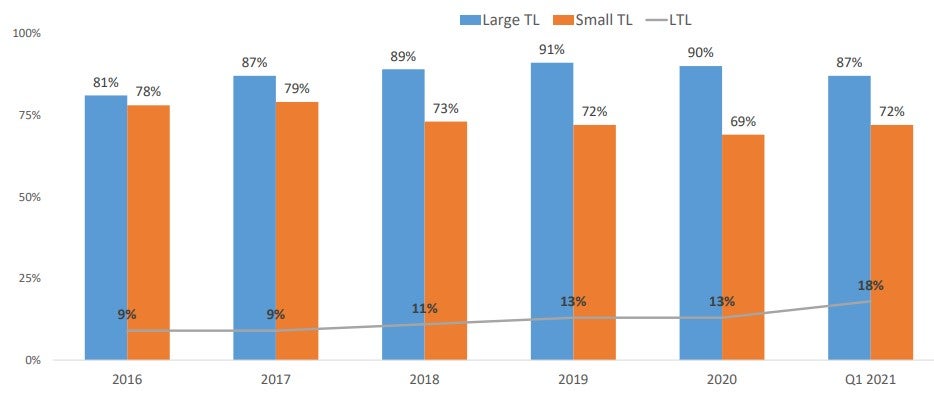A long-standing gap between how the U.S. Department of Transportation and the U.S. Department of Labor view driver wages must be bridged before the trucking industry will have a shot at curing its chronic driver retention problem, according to a university researcher.
Speaking at the Federal Motor Carrier Safety Administration’s Motor Carrier Safety Advisory Council (MCSAC) meeting on Monday, Michael Belzer, an economics professor at Wayne State University, told attendees that wage requirements under the DOL-enforced Fair Labor Standards Act conflict with FMCSA hours-of-service regulations that allow drivers to be unpaid while they wait to load and unload at a shipper or receiver facility.
“The Wage and Hour Division at the Department of Labor requires that employers pay for all work time, and covers the entire labor market,” said Belzer, a former Teamsters driver. “But FMCSA allows employers to declare drivers off duty while keeping them on the job. That’s a very different definition. Drivers’ time does not belong to them.”
Belzer contends that DOT and DOL have to “bridge the gap together” to fix the problem. “DOL and DOT can rebuild the truck driver labor market and solve this problem. Through interagency cooperation they can fix the driver shortage and create a workforce development solution that is stable.”
MCSAC took up the discussion because driver pay and retention can have a direct effect on driver safety. At a low pay rate, drivers work as many hours as necessary to reach target earnings that allow them to pay their bills, Belzer said. Drivers earning higher pay will rest rather than work extra hours that damage their health, risk their safety or keep them away from their families, he pointed out.

Source: American Trucking Associations
“Our research has been able to demonstrate that rising wages do not lead to driver greed — which is one of the things that people think might happen — they’re getting paid more money to make more runs. But no, the work is so damaging that they’ll reject loads once they reach those target earnings.”
Half of all truck drivers work more than 60 hours per week, according to Belzer. Nondriving, unpaid labor averages 25% of their work time — which leads many to quit. “Shippers avoid paying for loading and unloading and detention time. That drives down the carrier revenue as well as driver pay. Drivers quit faster than carriers can hire new drivers, and they quit the supply chain industry because it abuses them.”
To address a sharp increase in trucking demand over the past year, trucking companies have been raising pay to attract drivers.
“Rising pay and benefits will continue to be the natural market reaction to the driver shortage,” according to the American Trucking Associations. “However, the data suggests it is much more complicated and more about quality of life/at-home time than pay. Despite rapidly increasing earnings, over-the-road (long-haul) employment is falling, yet local trucking employment is rising or holding steady depending on the sector.”
Jerrold Langer, director of sales and marketing for liquid bulk carrier Langer Transport Corp. and a member of MCSAC, agreed that the industry has to reconfigure how drivers are viewed within the supply chain if trucking companies are going to boost retention rates long term.
“It seems that [shippers and receivers] need to feel the ramifications for not stepping up to the plate and not doing what’s right,” Langer commented at the meeting. “I think they know full well we have a driver problem,” but some will figure out how to avoid paying, he said.
“If we make the Fair Labor Standards Act fully applicable to truck drivers, then it’s much more likely we can establish a foundation for this,” Belzer said. “It’s going to be difficult to get shippers to pay, but they have to understand that if they want service they’re going to have to pay for it.”











Adam w
Wouldn’t have this problem if you would pay percentage, I really enjoy percentage pay I’ve been on mileage pay hourly, percentage is the best however not many companies are willing to do that because then drivers would be making dollars per mile rather than cents.
Stephen Webst
In Ontario Canada we need manitory detection pay of 55cd or 45 U S per hour to the truck after brokage fees are taken off. We need a min pay rate of 27per hour for O T R drivers on payroll or 33 dollars per hour for corporate accounts. E logs will just make a truck driver shortage. A much better solution is overtime pay after 10 hours per day.
Stephen Webst
In Ontario Canada many people got their truck drivers permit then only drive for one to 3 years because of low pay and unpaid overtime. Also many former truck drivers are living in homeless shelters. I and many other people have trench foot. Without more parking and shipping companies and receiving not providing overnight parking trucking is a very bad job in Ontario Canada.